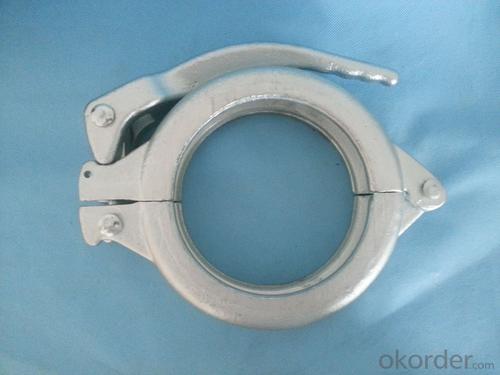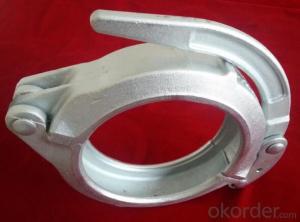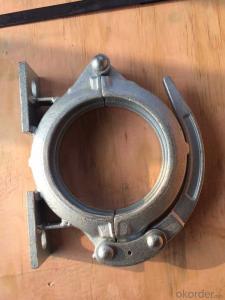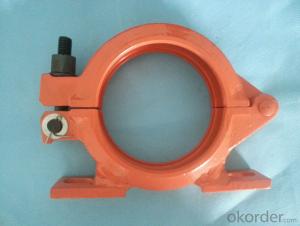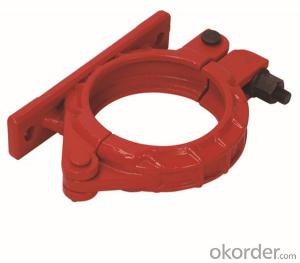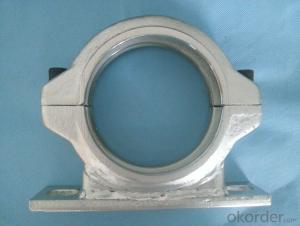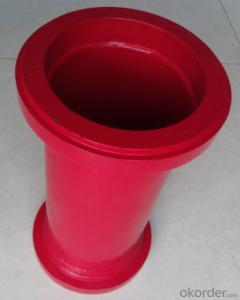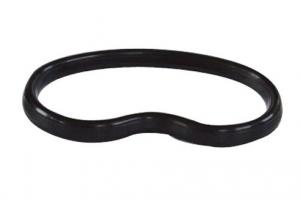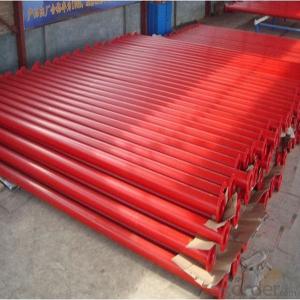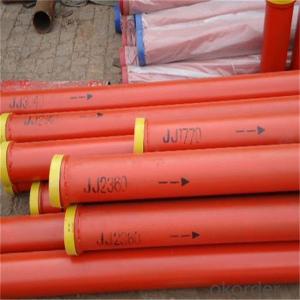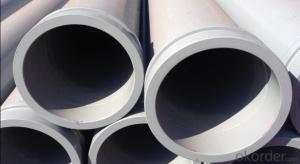Concrete Pump Adjustable Clamp DN125 Forged
- Loading Port:
- China main port
- Payment Terms:
- TT OR LC
- Min Order Qty:
- 20 PCS
- Supply Capability:
- 10000 PCS/month
OKorder Service Pledge
OKorder Financial Service
You Might Also Like
Product Description:
A coupling is a device used to connect two delivery pieps together at their ends for the purpose of transmitting, and prevent the concrete from leaking. Couplings do not normally allow disconnection of shafts during operation.
Main Product Features:
1. use high quality steel .After high-temperature 1200 forging,it’s shaped.
2.High temperature forging.
3.convenient to use, easy operation,and high safety.
4.good sealing,wear-resising,longer service life.
5.do not restrict the steering tubes, pipes during the working process can be 360 degrees rotation.
6.used in concrete pump truck,concrete pump and pipeline connection seal in construction work equipment.
Product Specifications:
1.Forged
2.2--8 inch
3.Galvanizing/Baking varnish
4.More durable,light,beautiful
Production Steps:

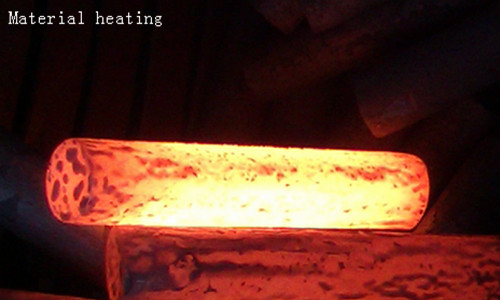
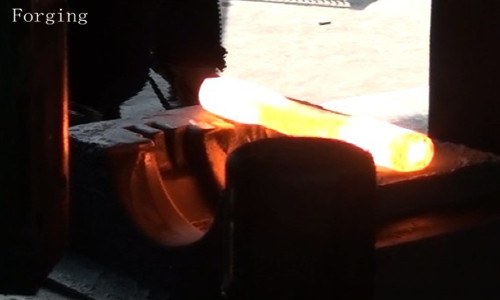

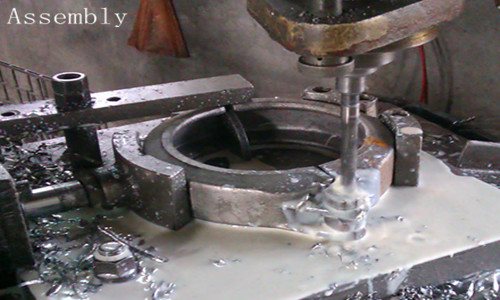



Concrete pump clamp Catalogue:
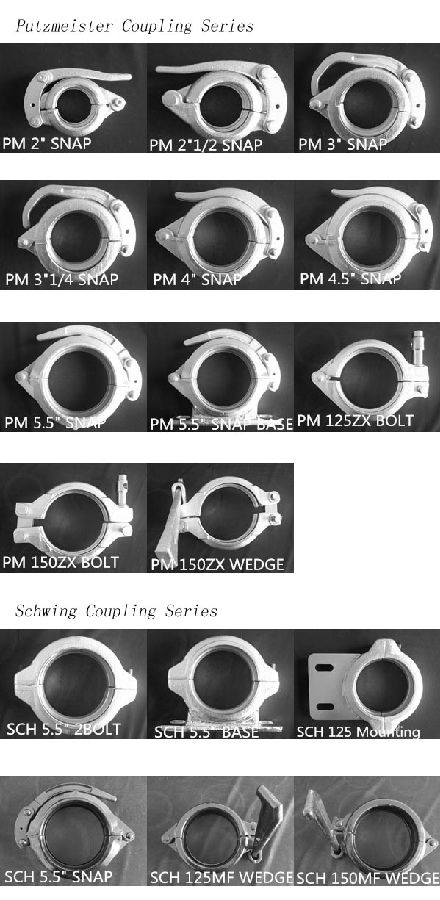

FAQ:
1.How do you regarding your product quality?
As our principle is more safety to save more. In China, there are lots of manufactures of this line, but we are the first one that use the forging technic in producing, firmly meet the PM standard.
2.Can I get some samples?
Of course you can. Small sample for free, but you pay the express. For some products are not small, like concrete pump pipe, it’s very difficult to deliver one pipe of 3000mm. If it’s possible, we’d like that you can come here to visit our factory. Welcome!
3. I want to make our logo on the products, is that ok?
Yes, it’s totally ok. OME is available from us.What you should do is send your logo, brand name, or picture to us. And let other things leave on us.
- Q: Are there any specific guidelines for the disposal of old or damaged concrete pump spare parts?
- Yes, there are specific guidelines for the disposal of old or damaged concrete pump spare parts. It is recommended to contact local waste management authorities or recycling facilities to inquire about proper disposal methods. In many cases, recycling concrete pump spare parts is encouraged to reduce environmental impact.
- Q: How does a hydraulic accumulator improve the performance of a concrete pump?
- A hydraulic accumulator improves the performance of a concrete pump by storing excess hydraulic pressure and energy during low-demand periods and releasing it when needed. This allows for a smoother operation, reduced pump pulsation, and improved efficiency in delivering the concrete, resulting in enhanced performance and productivity.
- Q: Can I get spare parts for both concrete pumps with and without boom control systems?
- Spare parts for both concrete pumps, with or without boom control systems, are generally available. Numerous manufacturers and suppliers offer a diverse selection of spare parts to cater to various pump types. Whether your pump has a boom control system or not, reliable suppliers should have the necessary spare parts in stock. To ensure compatibility and check availability for your specific concrete pump model, it is advisable to directly contact the manufacturer or supplier.
- Q: How can I extend the lifespan of my concrete pump spare parts?
- To maximize the durability of your concrete pump spare parts, there are several essential measures you can take: 1. Maintenance should be a priority: Establish a comprehensive maintenance schedule for your concrete pump, which includes regular examinations, cleaning, and lubrication of the spare parts. By promptly identifying and addressing any issues, you can prevent further harm and prolong the lifespan of the parts. 2. Invest in top-quality spare parts: Consider purchasing high-quality spare parts from reputable manufacturers. While cheaper alternatives may save you money initially, they tend to wear out faster and require frequent replacements. Opting for quality parts guarantees their longevity and durability. 3. Proper storage is crucial: Store your spare parts in a clean, dry, and well-organized environment. Continuous exposure to moisture, extreme temperatures, and dirt can lead to deterioration over time. To shield the parts from dust and other contaminants, consider using protective covers or cases. 4. Train your operators effectively: Proper operation of the concrete pump is vital in preventing unnecessary wear and tear on the spare parts. Make sure your operators receive thorough training and adhere to the manufacturer's guidelines for usage and maintenance. Discourage any misuse or improper handling of the equipment, as this can result in premature wear of the spare parts. 5. Regularly clean your equipment: Ensure that your concrete pump remains clean by regularly removing any concrete buildup. The accumulation of hardened concrete can strain the spare parts and cause premature failure. Utilize appropriate cleaning methods and tools to ensure thorough removal without causing damage. 6. Promptly address repairs: As soon as you identify any issues or damage to the spare parts, address them promptly. Ignoring or delaying repairs can exacerbate the problem and potentially harm other components. Regularly inspect the spare parts for signs of wear, such as cracks, leaks, or excessive vibration, and promptly resolve any concerns. 7. Monitor usage and performance: Keep track of the usage and performance of your concrete pump and spare parts. Regularly assess the wear and tear of the parts and the overall performance of the pump. Analyze any patterns or trends that may indicate potential problems and take corrective actions to prevent further damage. By implementing these measures, you can significantly extend the lifespan of your concrete pump spare parts, ensuring optimal performance and reducing the need for frequent replacements.
- Q: How often should concrete pump hydraulic motors be inspected and replaced?
- Concrete pump hydraulic motors should be inspected regularly, ideally every 500 to 1000 hours of operation, to ensure they are in good working condition. However, the frequency of replacement depends on various factors such as usage intensity, maintenance practices, and the quality of the motor. Generally, hydraulic motors can last for several years if properly maintained, but if any signs of wear, leakage, or reduced performance are observed, it is recommended to replace them promptly to prevent potential breakdowns or accidents.
- Q: What is the role of a concrete pump hopper grate spring?
- The role of a concrete pump hopper grate spring is to provide tension and support to the hopper grate in a concrete pump. The grate spring is typically made of durable and flexible material, such as steel or rubber, and is designed to keep the hopper grate securely in place while allowing it to move and flex as needed during the concrete pumping process. The hopper grate spring helps to prevent the hopper grate from becoming dislodged or damaged by the force and vibrations generated by the concrete pump. It ensures that the grate remains properly aligned and in position, allowing for the smooth and efficient flow of concrete into the pump. Additionally, the grate spring helps to reduce the impact and stress on the hopper grate, extending its lifespan and reducing the need for frequent repairs or replacements. It acts as a buffer, absorbing and distributing the forces exerted on the grate, which can be significant due to the weight and pressure of the concrete being pumped. Overall, the concrete pump hopper grate spring plays a crucial role in maintaining the integrity and functionality of the hopper grate, ensuring the safe and efficient operation of the concrete pump.
- Q: What is the function of a concrete pump control valve?
- The function of a concrete pump control valve is to regulate the flow and pressure of the concrete being pumped, allowing for precise control and efficient delivery of the material to the desired location.
- Q: What is the function of a concrete pump hopper grate clamp?
- A concrete pump hopper grate clamp is designed to securely hold the grate in place on the hopper, preventing it from shifting or becoming dislodged during the concrete pumping process.
- Q: How does the concrete pump work?
- The construction of automobile chassis, internal combustion engine, air compressor, water pump, hydraulic device, etc., which constitute the concrete pump truck, shall be operated in accordance with the safety instructions of the horizontal transport machinery, power plant and hydraulic machinery respectively
- Q: What are the common signs of wear and tear in a concrete pump cylinder?
- Some common indications that a concrete pump cylinder is experiencing wear and tear include: 1. Leakage of oil or hydraulic fluid: The presence of oil or hydraulic fluid leaking from the cylinder is a clear indication that it has sustained damage or wear. This could be a result of cracks, worn seals, or damaged gaskets. 2. Decreased pumping efficiency: A worn cylinder may lead to a reduction in pumping efficiency, resulting in the concrete pump's inability to deliver the same amount of concrete as before. This decline could be due to a decrease in the cylinder's internal diameter or worn piston rings. 3. Heightened noise and vibration: As the cylinder deteriorates, it may produce more noise and vibration during operation. This can suggest issues like misalignment, loose components, or damaged internal parts. 4. Uneven or rough concrete output: A worn cylinder can cause the concrete output to be uneven or rough. This issue may arise from an irregular internal surface or damaged piston rings, which disrupt the smooth movement of the piston. 5. Excessive generation of heat: A worn concrete pump cylinder may generate additional heat while in operation. This can be attributed to increased friction between moving parts, which can further contribute to accelerated wear and tear. 6. Visible damage or corrosion: By inspecting the cylinder's surface, visible signs of wear and tear such as scratches, dents, or corrosion can be identified. These damages can compromise the cylinder's integrity and may necessitate repair or replacement. It is crucial to regularly inspect the concrete pump cylinder and promptly address any signs of wear and tear to prevent further damage and maintain the pump's optimal performance.
Send your message to us
Concrete Pump Adjustable Clamp DN125 Forged
- Loading Port:
- China main port
- Payment Terms:
- TT OR LC
- Min Order Qty:
- 20 PCS
- Supply Capability:
- 10000 PCS/month
OKorder Service Pledge
OKorder Financial Service
Similar products
Hot products
Hot Searches
Related keywords



